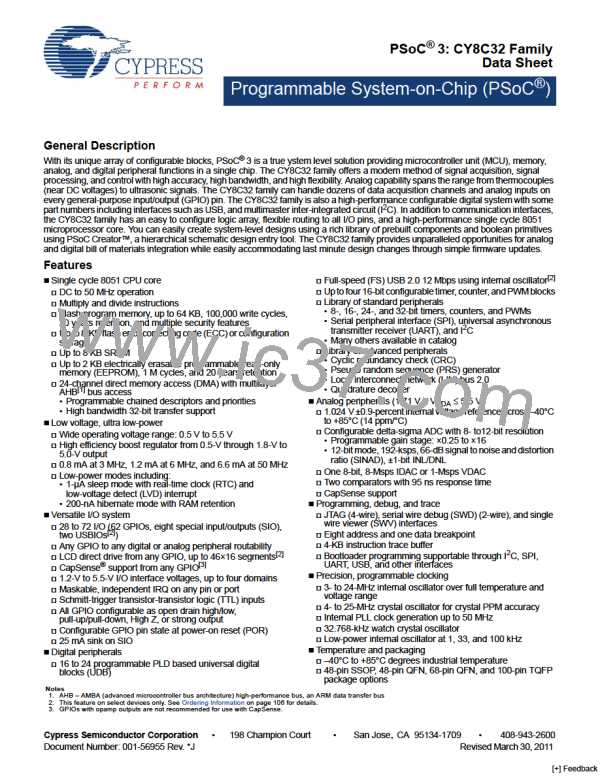PSoC® 3: CY8C32 Family
Data Sheet
The PLL block provides a mechanism for generating clock
frequencies based upon a variety of input sources. The PLL
outputs clock frequencies in the range of 24 to 50 MHz. Its input
and feedback dividers supply 4032 discrete ratios to create
almost any desired system clock frequency. The accuracy of the
PLL output depends on the accuracy of the PLL input source.
The most common PLL use is to multiply the IMO clock at 3 MHz,
where it is most accurate to generate the CPU and system clocks
up to the device’s maximum frequency.
Figure 6-2. MHzECO Block Diagram
XCLK_MHZ
4 - 25 MHz
Crystal Osc
The PLL achieves phase lock within 250 µs (verified by bit
setting). It can be configured to use a clock from the IMO,
MHzECO or DSI (external pin). The PLL clock source can be
used until lock is complete and signaled with a lock bit. The lock
signal can be routed through the DSI to generate an interrupt.
Disable the PLL before entering low-power modes.
Xo
(Pin P15[0])
Xi
(Pin P15[1])
4 – 25 MHz
crystal
External
Components
6.1.1.4 Internal Low-Speed Oscillator
Capacitors
The ILO provides clock frequencies for low-power consumption,
including the watchdog timer, and sleep timer. The ILO
generates up to three different clocks: 1 kHz, 33 kHz, and
100 kHz.
6.1.2.2 32.768-kHz ECO
The 1 kHz clock (CLK1K) is typically used for a background
‘heartbeat’ timer. This clock inherently lends itself to low-power
supervisory operations such as the watchdog timer and long
sleep intervals using the central timewheel (CTW).
The 32.768-kHz External Crystal Oscillator (32kHzECO)
provides precision timing with minimal power consumption using
an external 32.768-kHz watch crystal (see Figure 6-3). The
32kHzECO also connects directly to the sleep timer and provides
the source for the RTC. The RTC uses a 1-second interrupt to
implement the RTC functionality in firmware.
The central timewheel is a 1 kHz, free running, 13-bit counter
clocked by the ILO. The central timewheel is always enabled,
except in hibernate mode and when the CPU is stopped during
debug on chip mode. It can be used to generate periodic
interrupts for timing purposes or to wake the system from a
low-power mode. Firmware can reset the central timewheel.
Systems that require accurate timing should use the RTC
capability instead of the central timewheel.
The oscillator works in two distinct power modes. This allows
users to trade off power consumption with noise immunity from
neighboring circuits. The GPIO pins connected to the external
crystal and capacitors are fixed.
Figure 6-3. 32kHzECO Block Diagram
The 100-kHz clock (CLK100K) works as a low-power system
clock to run the CPU. It can also generate time intervals such as
fast sleep intervals using the fast timewheel.
XCLK32K
32 kHz
The fast timewheel is a 100-kHz, 5-bit counter clocked by the ILO
that can also be used to wake the system. The fast timewheel
settings are programmable, and the counter automatically resets
when the terminal count is reached. This enables flexible,
periodic wakeups of the CPU at a higher rate than is allowed
using the central timewheel. The fast timewheel can generate an
optional interrupt each time the terminal count is reached.
Crystal Osc
Xo
Xi
(Pin P15[2])
The 33-kHz clock (CLK33K) comes from a divide-by-3 operation
on CLK100K. This output can be used as a reduced accuracy
version of the 32.768-kHz ECO clock with no need for a crystal.
(Pin P15[3])
32 kHz
crystal
External
Components
6.1.2 External Oscillators
Capacitors
6.1.2.1 MHz External Crystal Oscillator
The MHzECO provides high frequency, high precision clocking
using an external crystal (see Figure 6-2). It supports a wide
variety of crystal types, in the range of 4 to 25 MHz. When used
in conjunction with the PLL, it can generate CPU and system
clocks up to the device's maximum frequency (see
“Phase-locked Loop” section on page 27). The GPIO pins
connecting to the external crystal and capacitors are fixed.
MHzECO accuracy depends on the crystal chosen.
6.1.2.3 Digital System Interconnect
The DSI provides routing for clocks taken from external clock
oscillators connected to I/O. The oscillators can also be
generated within the device in the digital system and Universal
Digital Blocks.
While the primary DSI clock input provides access to all clocking
resources, up to eight other DSI clocks (internally or externally
generated) may be routed directly to the eight digital clock
Document Number: 001-56955 Rev. *J
Page 28 of 119
[+] Feedback

 CYPRESS [ CYPRESS ]
CYPRESS [ CYPRESS ]